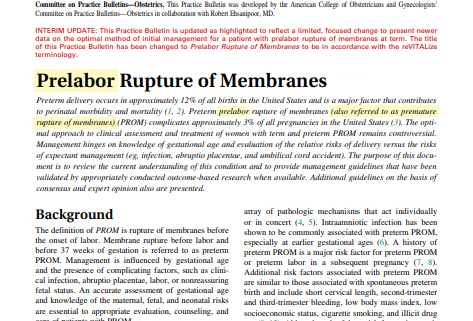PRELABOR RUPTURE OF MEMBRANES
Preterm delivery occurs in approximately 12% of all births in the United States and is a major factor that contributes to perinatal morbidity and mortality (1, 2). Preterm prelabor rupture of membranes (also referred to as premature rupture of membranes) (PROM) complicates approximately 3% of all pregnancies in the United States (3). The optimal approach to clinical assessment and treatment of women with term and preterm PROM remains controversial. Management hinges on knowledge of gestational age and evaluation of the relative risks of delivery versus the risks of expectant management (eg, infection, abruptio placentae, and umbilical cord accident). The purpose of this document is to review the current understanding of this condition and to provide management guidelines that have been validated by appropriately conducted outcome-based research when available. Additional guidelines on the basis of consensus and expert opinion also are presented.
Background
The definition of PROM is rupture of membranes before the onset of labor. Membrane rupture before labor and before 37 weeks of gestation is referred to as preterm PROM. Management is influenced by gestational age and the presence of complicating factors, such as clinical infection, abruptio placentae, labor, or nonreassuring fetal status. An accurate assessment of gestational age and knowledge of the maternal, fetal, and neonatal risks are essential to appropriate evaluation, counseling, and care of patients with PROM.



